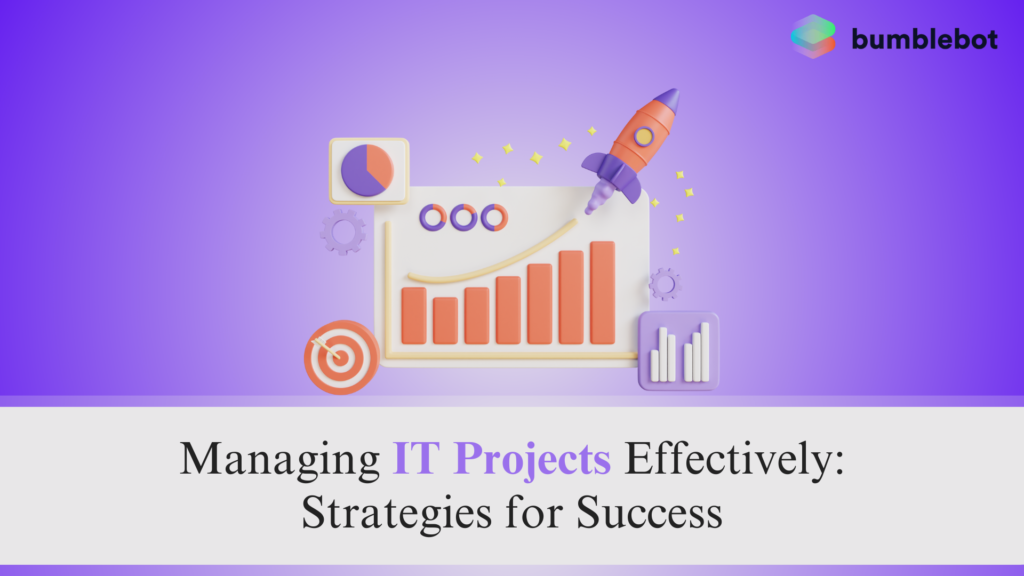In a fast-changing tech world, handling IT projects well is very important for companies to keep up with competition. Sustainable IT practices not only contribute to reducing IT cost operations but also play a pivotal role in improving productivity. Good management helps finish projects on time and within budget. This blog discusses key methods for dealing with IT project challenges and introduces Bumblebot Technologies, which is at the forefront of creative IT solutions, including device experience management and employee experience management.
- Define Clear Objectives and Scope
Every successful IT project starts by setting clear goals and defining what needs to be done. Using SMART goals—specific, measurable, achievable, relevant, and time-bound—helps everyone involved understand what the project aims to achieve. Sustainable IT practices, such as reducing IT cost operations, ensure that resources are used efficiently and effectively, aligning with the project’s scope.
- Implement Robust Planning and Scheduling
A good plan is essential for managing projects effectively. It should have a detailed schedule, a plan for using resources, and strategies for dealing with potential problems. Using tools like Gantt charts and the Critical Path Method (CPM) can really help managers see the project’s timeline and how different tasks depend on each other. Device experience management ensures that technology resources are optimized, contributing to efficient planning and scheduling.
- Assemble the Right Team
The success of an IT project mostly hinges on the team working on it. It’s important to put together a team that has the right set of skills and experience. Also, holding regular training sessions and team-building activities helps improve teamwork and efficiency. This makes sure the team stays motivated and ready to meet the project’s needs. Employee experience management fosters a positive work environment, enhancing team collaboration and productivity.
- Utilize Agile Methodologies
Agile methods like Scrum and Kanban make project management flexible and progressive. They divide the project into small, manageable parts and use regular updates from stakeholders. This approach makes it easier to adjust to changes and improves teamwork. Reduction in IT cost operations allows for more agile resource allocation, facilitating the implementation of agile methodologies.
- Focus on Communication
In IT project management, it’s very important to communicate well. Keeping everyone informed through clear and regular updates helps all stakeholders—like the team, management, and clients—stay aligned. Sustainable IT practices promote transparent communication, fostering trust and cooperation among stakeholders.
- Monitor and Control Project Progress
It’s important to keep an eye on how the project is doing compared to the plan. This means checking things like milestones, how much money is being spent, and how well the project is performing overall. Using project management software can make it easier to watch these things in real-time and report on them, which helps make decisions quickly when needed. Sustainable IT practices integrate efficient monitoring and control mechanisms, ensuring that projects stay on track and within budget.
- Embrace Change Management
Change is bound to happen in IT projects. Using a structured change management process lets you understand how changes affect things and decide wisely. This process needs a straightforward way to ask for changes and ways to evaluate and carry out those changes well. Sustainable IT practices provide a framework for effective change management, minimizing disruptions, and maximizing project success.
- Ensure Quality Control
Quality is crucial at every stage of the project. Make sure to include regular testing and reviews in the project timeline to catch any issues early and meet all requirements. Sustainable IT practices emphasize the importance of quality control, ensuring that deliverables meet standards and expectations.
Conclusion: Partner with Bumblebot Technologies
Managing IT projects well means having the right skills and tools. That’s where Bumblebot Technologies comes in. We offer a range of services and tools to make your project management smoother. With us, your IT projects will be on time, within budget, and top-notch. Whether you need to streamline workflows or add new tech, we’re here to help, ensuring sustainable IT practices and enhancing device experience management and employee experience management throughout your project lifecycle.
To Know More – The Impact of Internet of Things (IoT) on IT Infrastructure


